Taken from my window in NYC!
Picture of the Day – Cherry Blossoms Abloom in Tudor City Park, NYC
Picture of the Day — Cloud Reflections

Beautiful cloud! with folds so soft and fair,
Swimming in the pure quiet air!
Thy fleeces bathed in sunlight, while below
Thy shadow o’er the vale moves slow…
…Beautiful cloud! I would I were with thee…
In NYC, even the clouds have an attitude! – April 2017. Time Warner Center, NYC.
Picture of the Day– A Rainy Day in NYC
What is it about the rain in NYC? Sometimes it can be soothing (the sound of the water dripping on your windowsill as it lulls you to sleep). Sometimes it can be inconvenient (getting your hair wet just as you walk out of the hair salon). Sometimes it can be refreshing (think a swelteringly humid day in late August). But sometimes it just makes everything look shiny and new. — April 25, 2018; 57th Street between First and Second Avenue.

A Haunted Well in NYC
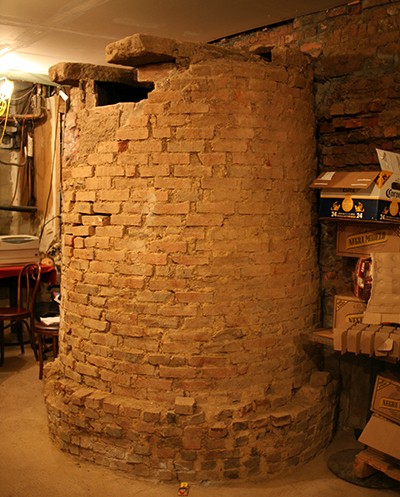
Want a little murderous New York City history with your shopping? Well, then head on over to the COS store on Spring Street for a glimpse of a two-hundred year old well that was the site of an infamous NYC murder.
Here’s the lowdown:
The Players
On the evening of December 22, 1799, Gulielma “Elma” Sands told her cousin Catherine Sands that she was running off to marry her beloved, Levi Weeks, a young man who lived in the same boarding house as she. Dressed in a shawl, hat and earmuffs, Elma set out on her romantic evening but sadly, she was never to be seen alive again.
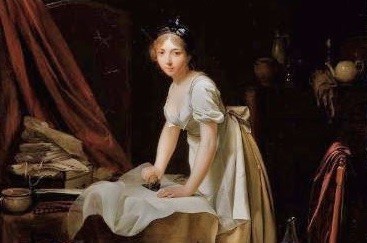
The Crime
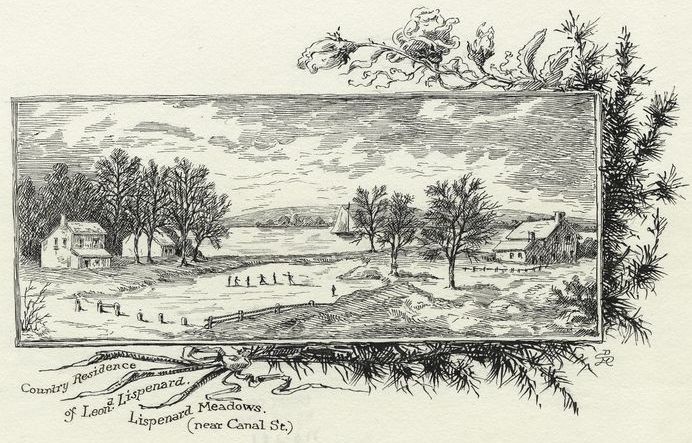
Several days later, a young boy found Elma’s muff in The Manhattan Well which was located in Lispenard’s Meadow which is now known as Spring Street. On January 2, 1800, Elma’s body was recovered from the well and a la Natalie Wood, strange marks and bruises were noted upon medical examination. It was later determined that Elma died not from drowning but from manual strangulation.
The Indictment
The Manhattan Well Murder, as it soon became known, was a New York City sensation. In what could be a precursor to the National Enquirer, handbills were distributed to the public implying that Weeks had impregnated Elma and that’s why he killed her. (Through medical examination however, it was determined that Elma was not pregnant.)
Eventually, public sentiment turned against Weeks and he was arrested for Elma’s murder.
Pre-Trial
Two items make this trial particularly noteworthy. Firstly, thanks to his wealthy brother Ezra’s connections, Weeks was able to retain three high-powered attorneys (the F. Lee Bailey, Johnny Cochran and Robert Shapiro of their day, if you will). Two of these attorneys you may have heard of–Henry Brockholst Livingston, Aaron Burr, and Alexander Hamilton. (It should also be noted that Burr may have had an ulterior motive to participate in this trial–he was the founder of the Manhattan Company that owned the well where Elma’s body was found.)
Second item of note, this was the first murder trial in American history to be fully documented by a court stenographer.
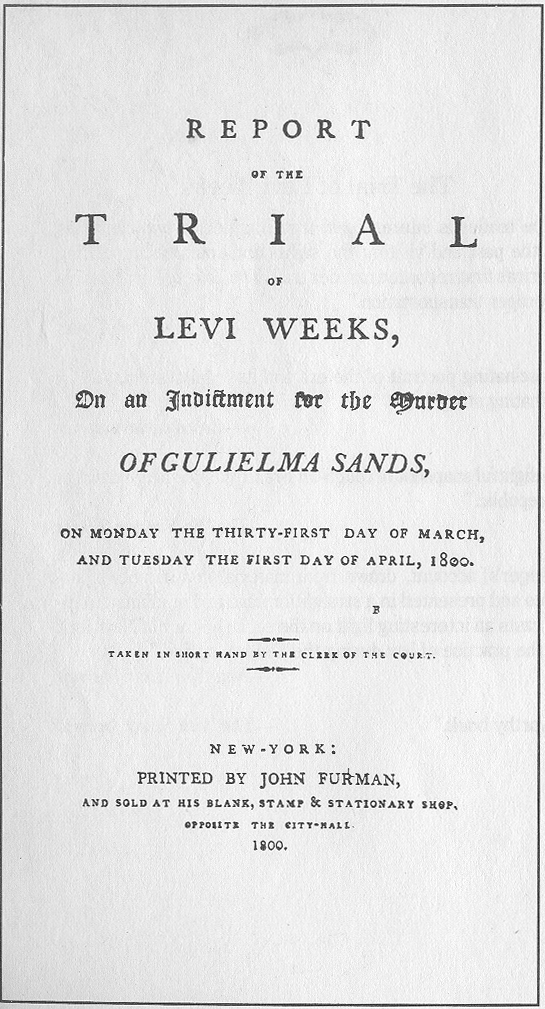
The Trial
Weeks’ trial began on March 31, 1800.
First up was the prosecution whose case appeared to be entirely circumstantial. One of the men who pulled the body from the well testified that Elma’s clothing had been torn and he believed her neck was broken. Medical testimony was given by a dentist who saw the body after the inquest. He mentioned the scratches and bruisings on her body, including a ring of bruises around her neck which made it appear that she had been strangled.
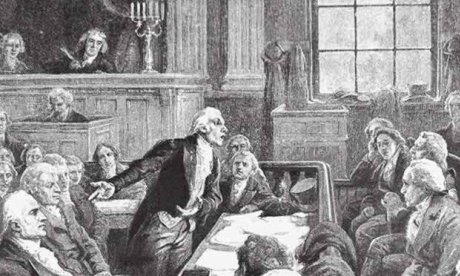
Elma’s cousin Catherine as well as other residents of the boarding house testified as to the relationship between Weeks and Elma and their plans to marry,
The defense meanwhile, asserted that Elma had committed suicide. Physicians who examined the body for the coroner’s jury (who had ruled the death murder), now believed she jumped into the well. Acquaintances of Elma described her character as “melancholy”, and one said she had spoken of killing herself with laudanum, an alcoholic solution containing morphine, prepared from opium They attempted to tarnish Elma’s reputation by introducing testimony that she had slept with her cousin’s husband (shades of Jerry Springer!) . Then there was Weeks’ alibi that he was with his brother and several friends during the evening in question. The defense produced several witnesses who testified to this.
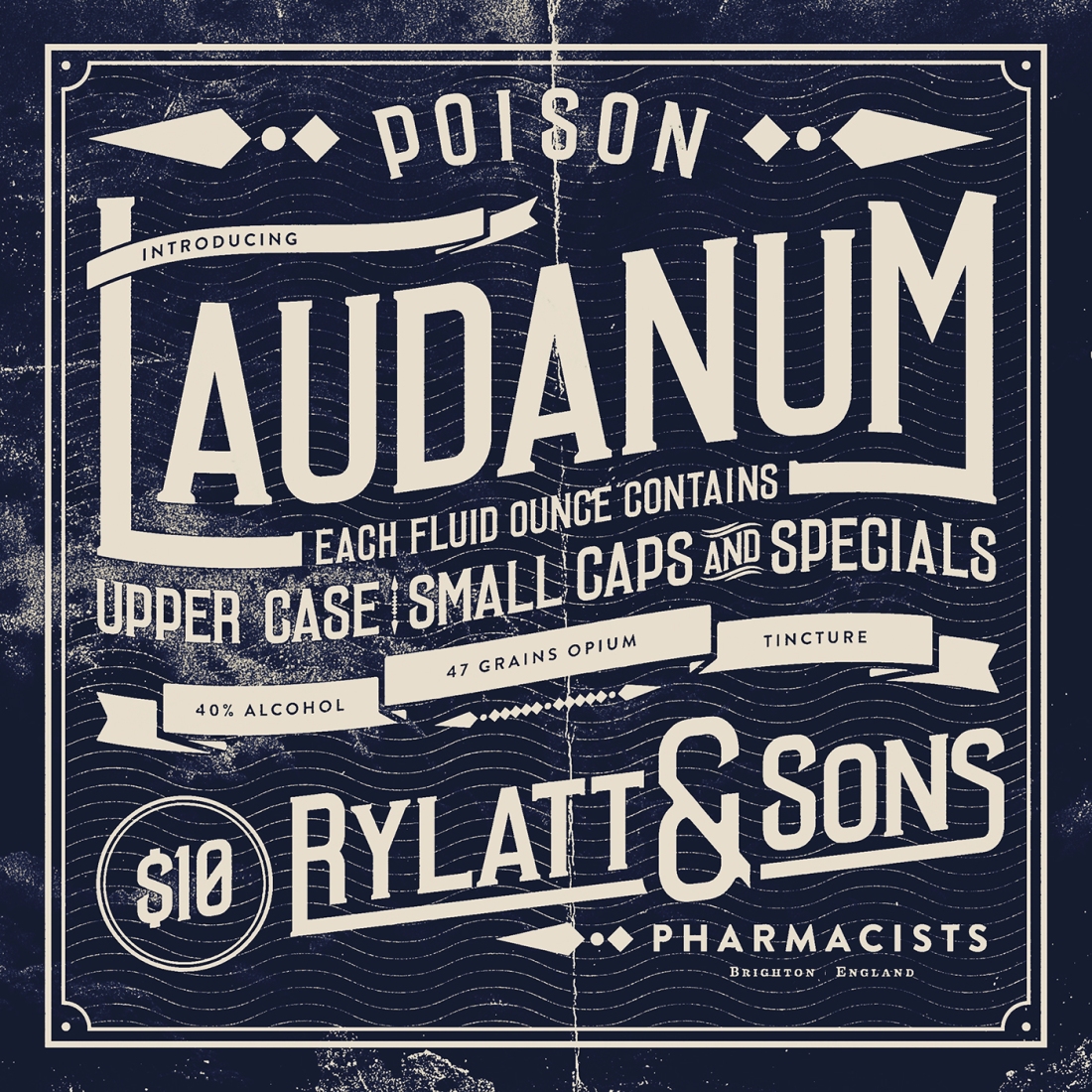
After one long day of testimony, Chief Justice John Lansing, Jr gave the case to the jury. The judge, being no Judge Judy by the way, instructed the jury that there was no sufficient proof against Levi Weeks to warrant a decision against him. He stopped short however, of a directed verdict.
The Verdict
After five minutes (!!) of deliberation, the jury returned their verdict of (shades of OJ), NOT GUILTY!!
The Aftermath
The Manhattan Well Murder remained a much-debated issue in New York City for many years to come. Although the State had failed to establish its case, and Judge Lansing’s instruction was proper, his charge to the jury was widely criticized as was the verdict.
So intense was the animosity against him, Weeks was forced to leave the city, first to Deerfield, Massachusetts. When the story followed him there he fled to Cincinnati, Ohio, then to Lexington Kentucky, finally settling in Natchez, Mississippi where he became a successful architect.
As for Hamilton and Burr, although they were bitter political rivals, for this particular trial they appeared to work well together. Their relationship changed however, when during the presidential election of 1800, Thomas Jefferson was pitted against Burr. A tie in the electoral college occured (we ALL know about the electoral college now, don’t we?!) and thanks to Alexander Hamilton’s influence, Jefferson was elected President.
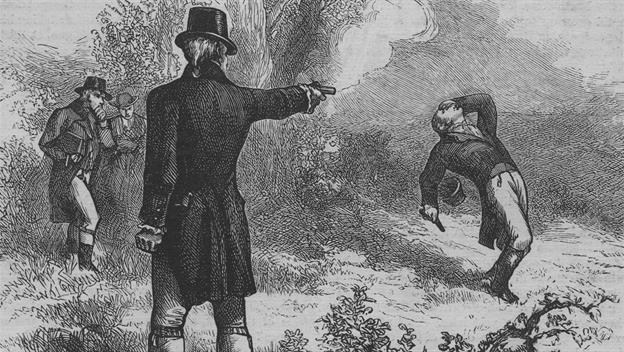
Animosity between Burr and Hamilton grew until on July 11, 1804 the two men fought a duel which ended with the death of Alexander Hamilton which then went on to be the basis of a successful musical on Broadway.
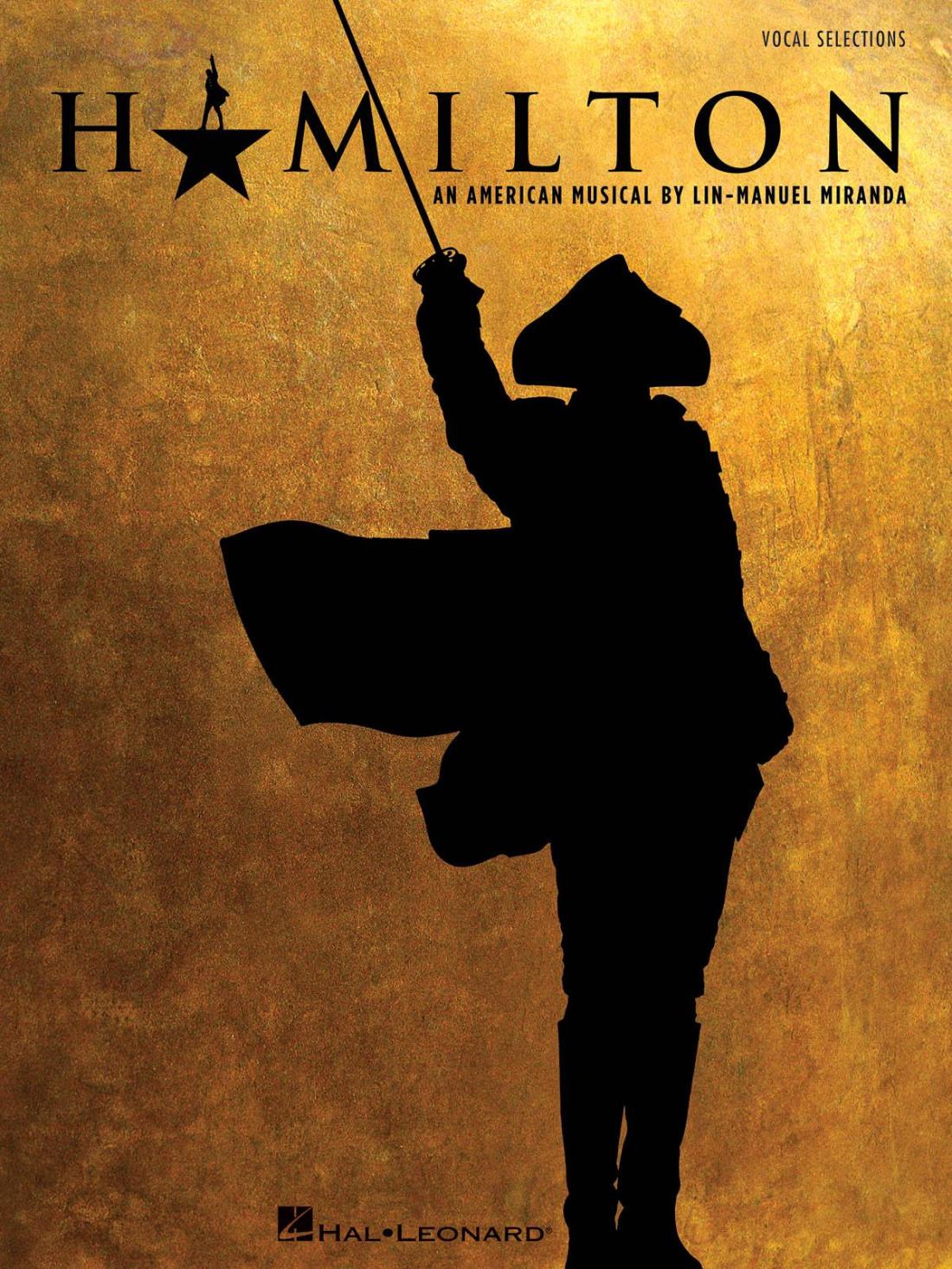
The Well
Over the years, as the face of New York City changed, the infamous well was covered up to make room for row houses and other assorted buildings. One of the structures that was built in 1817 is a four-story building at 129 Spring Street which sits right on top of where the well so visibly stood.
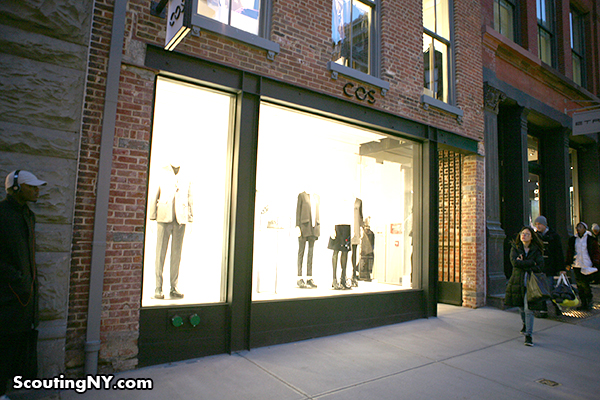
Fast forward about a hundred years to 1954 and the building was bought by the family of Maria DaGrossa who turned it into the restaurant, the Manhattan Bistro.
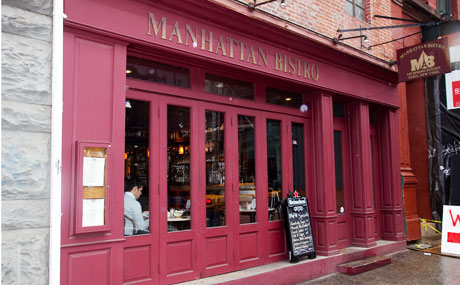
Then in 1980, DaGrossa’s mother was so intrigued she decided to have the basement excavated. Soon enough, the well was unearthed–all seven feet tall and five feet wide of it!
Over the years, many of the restaurant’s staff reported strange happenings, and some believed Sands’s ghost haunted the property. DaGrossa says she’s unsure how, but twice bottles have inexplicably flew off the shelves behind the Bistro’s bar. She also says neighbors claimed to have heard groans and rattling chains in the alley behind the restaurant.
After closing its doors in 2013 (perhaps due to its horrible Yelp reviews–maybe Elma really cursed the place!), the restaurant was remade into the current COS store.
While DeGrasso only allowed certain visitors into the basement to see the well, it’s now in full view where it sits prominently amongst the mannequins in the men’s department.
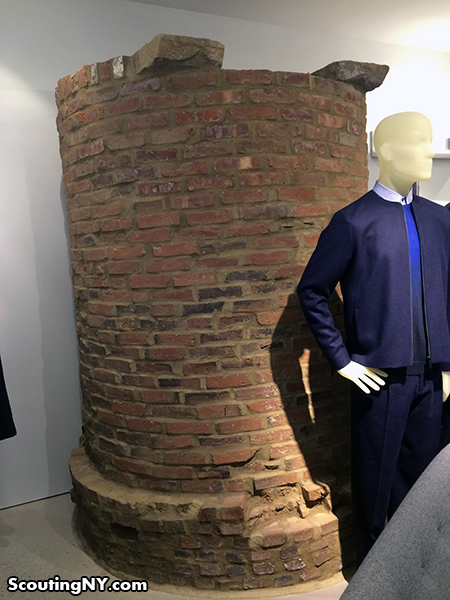
A postscript to all this however, is that there’s a Nancy Naysayer, a Debbie Downer who claims that the well is not THE well!
According to Joan Geismar, a founding member of the Professional Archaeologists of New York City, the well appears to be more of a cistern. As she says in a Village Voice article, “Wells from 1799 were typically made of stone, not brick…the COS well is more like the usual size of a cistern”. She also states that the well was “in the rear of a carpenters’ shop at the end of an alley, No. 89½ Greene Street, a hundred feet or more north of Spring Street.”
Well, be it a well or cistern, if you’re ever in the vicinity of 129 Spring Street, come pay your respects to Elma…I’m sure she’ll appreciate your company!
How a High Society Murder-Suicide Sparked NYC’s First Gun Control Law
Just as gun control is a hot button issue today, it really wasn’t that much different a hundred years ago. But it was a high-profile murder-suicide that actually forced a change and led to the creation of NYC’s first gun control law.
The Players
Some writers use the trick of taking people that they know in real life and turning them into characters in their stories. Usually, things turn out just fine. If there is a case of it usually is handled in court or the two sides reach an agreement. But in the case of author David Graham Phillips, such was not the case. His murder was deemed the “most spectacular crime in American literary history”.
Phillips was a controversial star of the literary world during the first decade of the twentieth century. He started his career as a journalist but he was also somewhat of a social crusader. In a series of articles for William Randolph Hearst’s Cosmopolitan magazine (one can assume this was not the Helen Gurley Brown version), Phillips profiled several United States senators who he alleged were corrupted by the likes of Rockefeller, Vanderbilt and Carnegie. The series, which was written in 1906, inspired President Theodore Roosevelt to attack Phillips as “The Man With the Muck Rake” (which by the way, introduced the term “muckraker” into the English language).
Thanks to his success and popularity as a journalist, Phillips then turned his talents to writing novels. He soon became a sort of Jackie Collins of his day, weaving tales of insurance, finance and politics with romantic love.
One of these novels however,“The Fashionable Adventures of Joshua Craig” apparently hit a little too close to home for one of its readers, Fitzhugh Coyle Goldsborough (yes, that was his real name!).
Goldsborough hailed from the gilded aristocracy that Phillips regarded as so destructive to America. An ancestor was a delegate to the Continental Congress who just missed out being a signer of the Declaration of Independence. Another was a commander in the War of 1812 who later became a senator. Fitzhugh’s father, a doctor and Civil War veteran, relocated the family to Washington, D.C., where Fitzhugh was raised in a home a few blocks from the White House.
Written in 1909, “The Fashionable Adventures of Joshua Craig” features a romance between a rugged yet brilliant political appointee from Minnesota (Craig) and Margaret Severance, described as a “fashionable noddle-head”…a member of a “frivolous, idle” family dwelling in a “sickly, sycophantic atmosphere” . For whatever reason, Goldsborough felt that the depiction of Margaret’s character was based too closely on his beloved sister.
So as any brother who feels his sister has been slighted (save for Rob Kardashian), Goldsborough decided to right this perceived wrong in his own particular way.
The Crime
So how did Goldsborough choose to handle the situation? Well, he did what any sane would do…he rented a room in an apartment building directly across the street from Phillips’ apartment building, stalked him, sent him chilling messages and finally chose to make Phillips pay the ultimate price. In essence, he became the Mark David Chapman to Phillips’ John Lennon.
From evidence retrieved from his apartment after the crime, it appeared that Goldsborough held quite the grudge against Phillips (albeit a rather bizarre one). Goldsborough not only because of the way his sister was depicted in the book but because he was convinced that Phillips could read his mind and was a vampire able to suck the life out of him. M’kay!
Renting a room on East 19th Street with a view of Phillips’s south-facing apartment in the National Arts Club on East 21st Street, Goldsborough was able to have a prime vantage point to spy on his enemy. And as Phillips was a man of regular habits, it was quite easy for Goldsborough to his comings and goings.
Thus it was on the afternoon of January 23, 1911, Goldsborough followed Phillips as he made his daily trek to the Princeton Club on Lexington and 21st Street. Running ahead of him, an armed Goldsborough blocked Phillips’ path and as was reported in The New York World, shouted “‘here you go!’ before pulling the trigger. After firing the sixth shot, Goldsborough paused an instant to glance at his victim through the cloud of powder smoke, then stepped to the curb. Without glancing again at Phillips he put the weapon to his right temple and exclaiming, ‘Here I go!’ sent a bullet into his brain, causing instant death.”
As for Phillips, he was brought to Bellevue where he survived for one day before passing. When asked if he knew his attacker, Phillips said he had no idea who it was although he claimed he had received several threatening phone calls and letters during the past few months one of which stated “this is your last day.”
Ultimately, it was this that led to the creation of New York City’s first gun control law.
Sullivan’s Law
The early 1900’s was a tough time for NYC. It was not uncommon for shootings in the streets to occur during the violent gang wars that rocked NYC’s immigrant neighborhoods.
Fearful for their lives, many New Yorkers felt that something drastic needed to be done. Thus it was right after the Goldsborough-Phillips murder-suicide, that George Petit le Brun, a clerk in the coroner’s office and an acquaintance of Graham Phillips, who finally got the ball rolling towards gun control.
After drawing up a list of recommendations for a proposed gun control bill for the State Legislature, le Brun delivered it to State Senator Timothy D. Sullivan, a Tammany Hall boss better known as “Big Tim” Sullivan.
Sullivan was something of an enigma— he was a successful state senator who helped fight for women’s rights and was already on record as pledging to introduce legislation that placed restrictions on guns. “The gun toter and the tough man – I don’t want his vote because I’m goin’ to try to put him in jail.” he said during his 1910 campaign. On the flip side however, Sullivan was also a Tammany Hall crime boss involved in the criminal underworld of gambling and prostitution. It was for this reason that many of Sullivan’s more cynical contemporaries felt that the law was a way for Sullivan to guarantee his bodyguards could be legally armed while using the law against his political opponents.
Eventually however, Sullivan turned le Brun’s recommendations into a bill which “mandated police-issued licenses for handguns and made it a felony to carry an unlicensed concealed weapon”. He presented the bill on the Senate floor and with support from the Merchants’ Association of New York, prominent civic leaders, and even oil baron John D. Rockefeller, the bill passed overwhelmingly in both houses and on August 31, 1911, The Sullivan Law as it became known, went into effect.
And while the NRA did not interfere in its creation, the law was not without its detractors. These consisted primarily of the gun manufacturers, a few state senators who felt this law violated the United States Constitution, and innocent citizens who felt that the law prevented them from keeping pistols in their homes for the purpose of self-defense. (Hmm, where have we all heard these arguments before!)
As for whether the law actually saved lives, unfortunately this was not the case. According to reports published in 1913, there were 106 murders committed in 1910. In 1912, the first full year under the Sullivan law, there were 108. It’s believed the upswing occured due to criminals acquiring guns from the good folks across the river in New Jersey where the law was not in effect.
Though it took awhile for the Sullivan Law is still on the books as section 400.00 of the New York Penal Law and has become a model for gun-control legislation enacted
November 8–It’s Beginning to Look a Lot Like…Christmas Already?!
New Yorkers just love Christmas. Retailers in New York City especially love Christmas. And every year it seems that New York City retailers are starting the Christmas decorating earlier every year.
On my way to work this morning, I spotted two stores that on this day, November 8–still two weeks BEFORE Thanksgiving–already have some pretty heavy duty Christmas decorations on display:
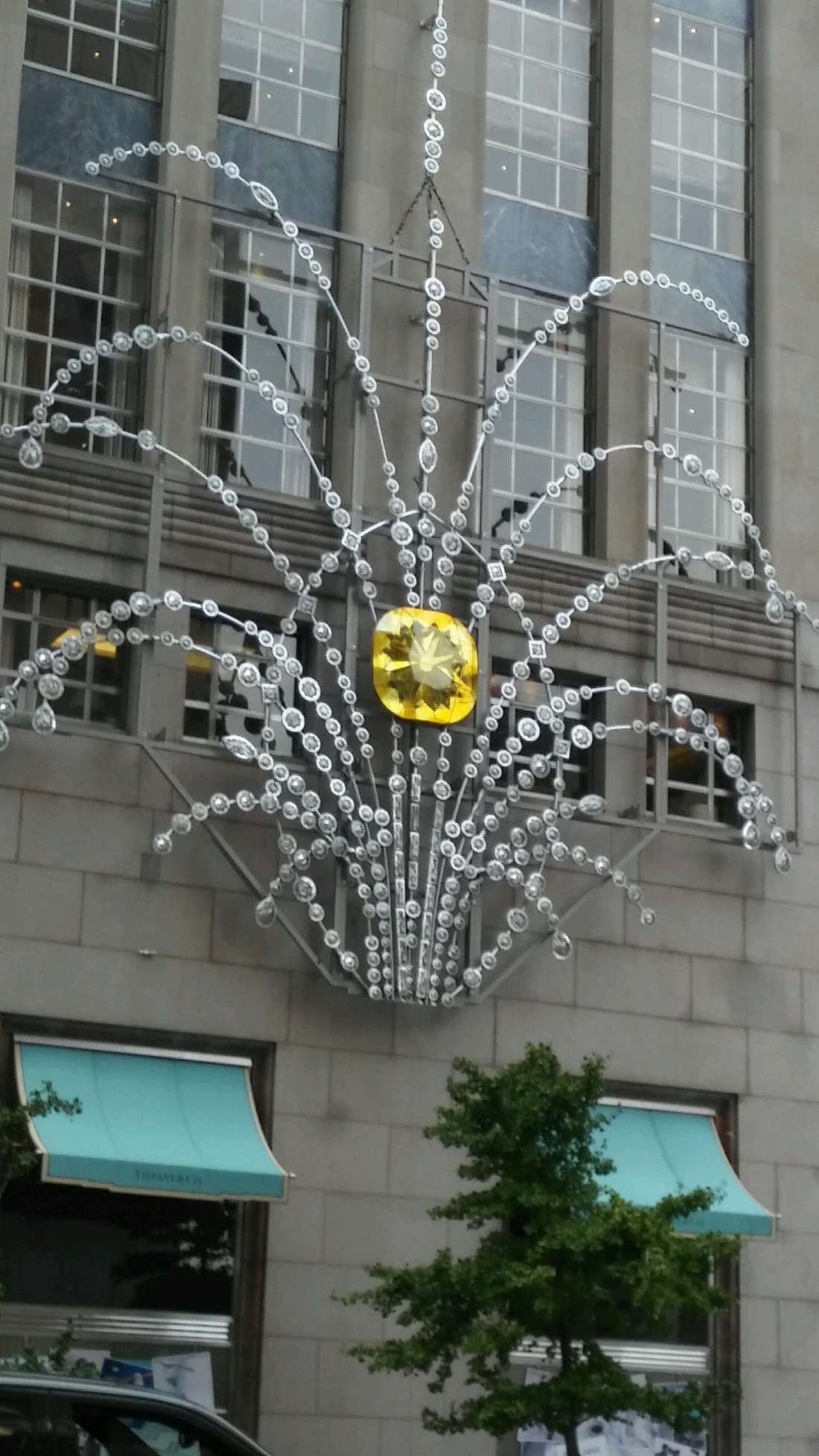
A Christmas Brooch on Tiffany’s

Some early…WAY TOO EARLY, Christmas offerings courtesy of Hammacher Schlemmer’s window

A cute stuffed bulldog from Hammacher Schlemmer’s you can have under your tree TODAY–a whole forty-seven days before Christmas!
Now call me old-fashioned, but I kinda like celebrating one holiday at a time. One of my favorite holiday movies is A Christmas Story and one of the things I love about it is the slow buildup to Christmas day. Ralphie and his family don’t shop for a tree–get this–until a whole two days before Christmas!! Holy St. Nick, Batman!! The holiday displays in the local stores don’t appear until a whole week before Christmas!
Now I know New York City is the retailing capital of the world and of course, the earlier these retailers get consumers to start thinking about Christmas, the more money they can potentially make. However, can’t we at least wait until the Thanksgiving turkey has been disposed of and the temperature dips to thirty degrees before we see the first tinsel on Bloomingdales’ tree?
How about you guys? What do you all think of this rushing through the holiday seasons? Feel free to post your own early NYC retail Christmas decoration viewings in the comments below. Also be sure to check back for updates on any “way too early NYC holiday decorations” I’ve spotted.
Horn and Hardart…The Starbucks of A Golden NYC Era
Okay, I admit it…I’m not a big coffee drinker. And when I do partake of the brew, it’s usually, (gasp!) plain, old decaf. And Starbucks?? While others are hooked on the coffee giant’s latte, I can sing love songs over their egg salad sandwich. But before Starbucks, there was a place that was well-known for their coffee and also served delectable fare…Horn and Hardart!
For those of you of a certain age, you may very well remember H&H as their go-to coffee shop with their gleaming art deco counters, the fragrance of hot brewed coffee and the hustle bustle of New Yorkers from a bygone era. For the uninitiated, here’s a brief history:
Back in 1888, Philadelphian Joseph Horn and German-born, New Orleans-raised Frank Hardart opened the very first coffee shop in Philadelphia. Blended with chicory, the New Orleans style coffee was the first fresh-dripped brewed coffee served in Philadelphia. Housed in a tiny 11×17 luncheonette with an open counter and only fifteen seats, the establishment soon became a huge success.
Not ones to rest on their laurels however, the duo soon became inspired by the “automat” restaurants popping up in Berlin. Here, customers helped themselves to food that was displayed in individual, closed glass compartments that were opened by dropping a coin into a corresponding slot. Once the customer helped themselves to the desired food item, the compartment would close and the space would be refilled. Sounds all high tech, like a well-oiled machine, right? Well, behind the scenes, it was actually all highly organized and well-staffed by a machine of the human variety who made sure each food item was quickly replaced.
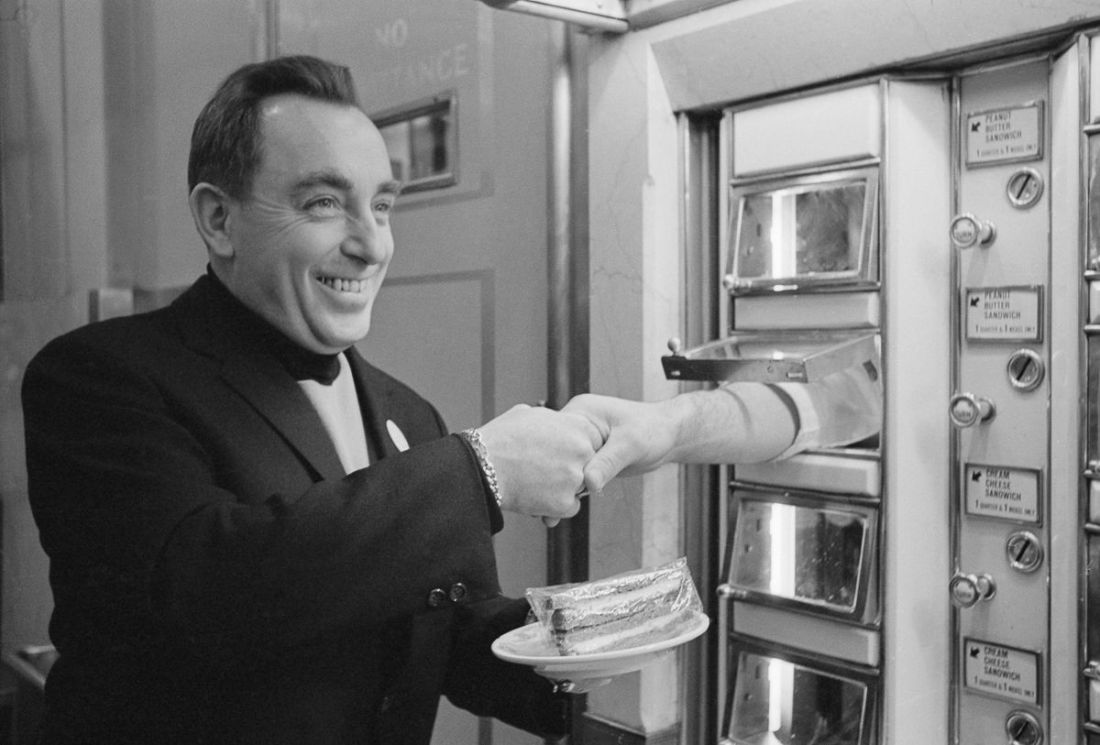
After acquiring one of these new fangled automated machines for themselves, the first H&H automat opened in Philadelphia in 1902. More importantly the first H&H automat in New York City opened in Times Square on July 2, 1912. And thus, a New York City institution was born.
For the price of a nickel or a dime, patrons helped themselves to a variety of food. Literally everything from soup to nuts was offered here. During the Great Depression, macaroni and cheese, creamed spinach and baked beans were the most popular food offerings.
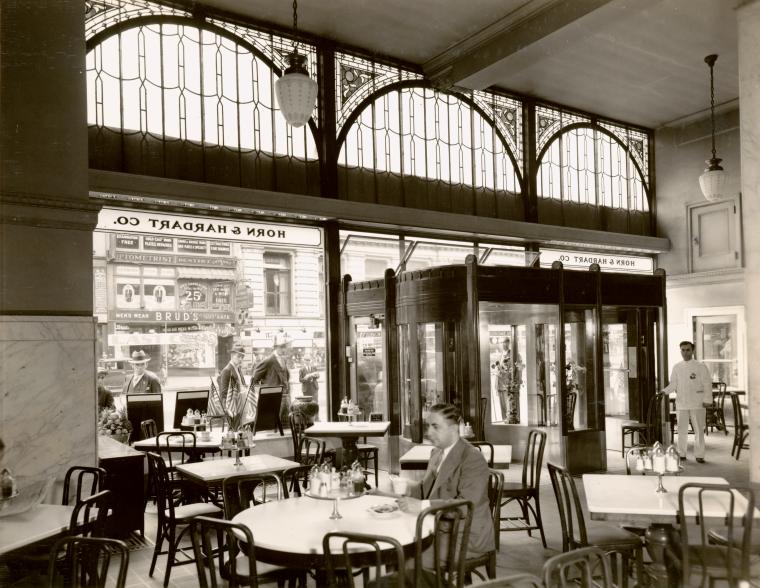
And while people may have come for the food, just like Starbucks, it was the coffee that kept them coming back. And the H&H managers took their coffee very seriously! As Carolyn Hughes Crowley describes in her article, Meet Me at the Automat, “between courses, samplers sipped black coffee. Each day that beverage came from a different Horn & Hardart outlet. In this way, Horn & Hardart performed spot checks on coffee…after brewing each batch of their coffee, Horn & Hardart employees filled out a time card. After 20 minutes, they discarded whatever coffee remained and prepared more.” Does Starbucks even do that???
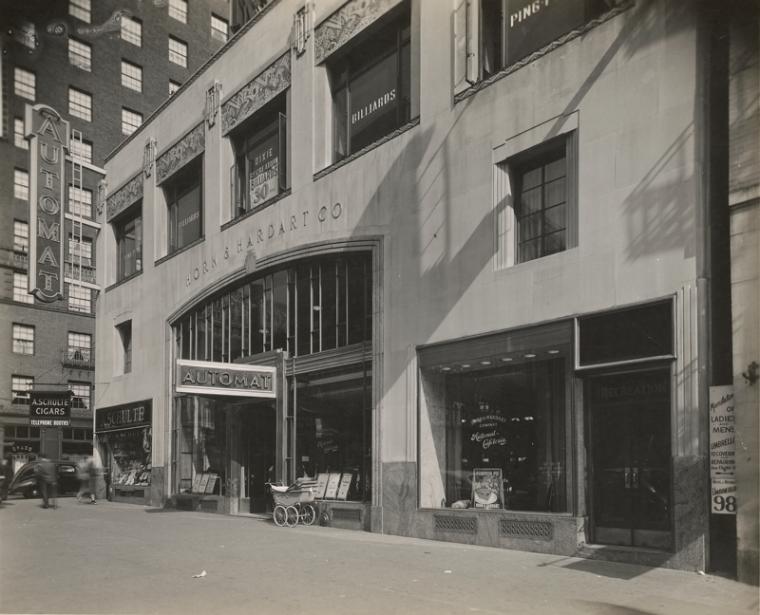
And all this persistence paid off. By the time of Horn’s death in 1941, H&H had a total of 157 restaurants between Philadelphia and New York City (fifty of them were in NYC and served 350,000 patrons a day). During their heyday in the 1950s, H&H sold more than ninety million cups of coffee a year. And the price for this delectable brew? From 1912 to 1950, a cup cost a mere nickel.
Adding to their success was H&H’s high standards of quality control which was of the utmost importance as food contamination scares was a by-product during that time. Every manager at each H&H was given a leather bound rule book that “listed the proper handling of the nearly 400 menu items,” In precise terminology, managers were directed “precisely where to position the buffet-style food on the plates and stated the number of times employees were to wipe tabletops each day.”
There was also a strict fresh food policy which stated that no food could be left overnight. If there were left overs, these items were redistributed to low income neighborhoods where they were sold at reduced prices at one of H&H’s “day old” shops.
The automat was also the great equalizer–if you were a prince or pauper, it didn’t matter. Everybody ate here all seated together. This was a big deal back in the day when many people were struggling to get back on their feet after the Great Depression or for those returning from war. Unlike some high falutin’ restaurants where the upper classes were separated from the lower classes, everybody ate together, no tipping was allowed and as there were no cash registers, “thrifty customers’ dining expenditures were discreetly hidden”.
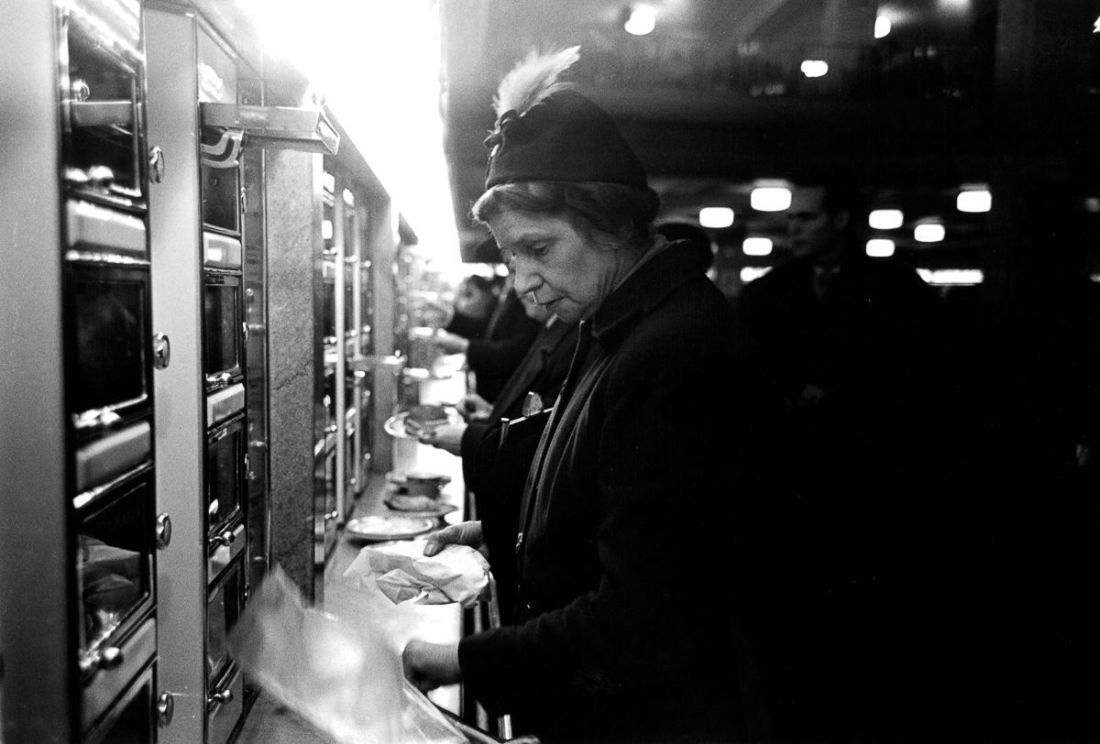
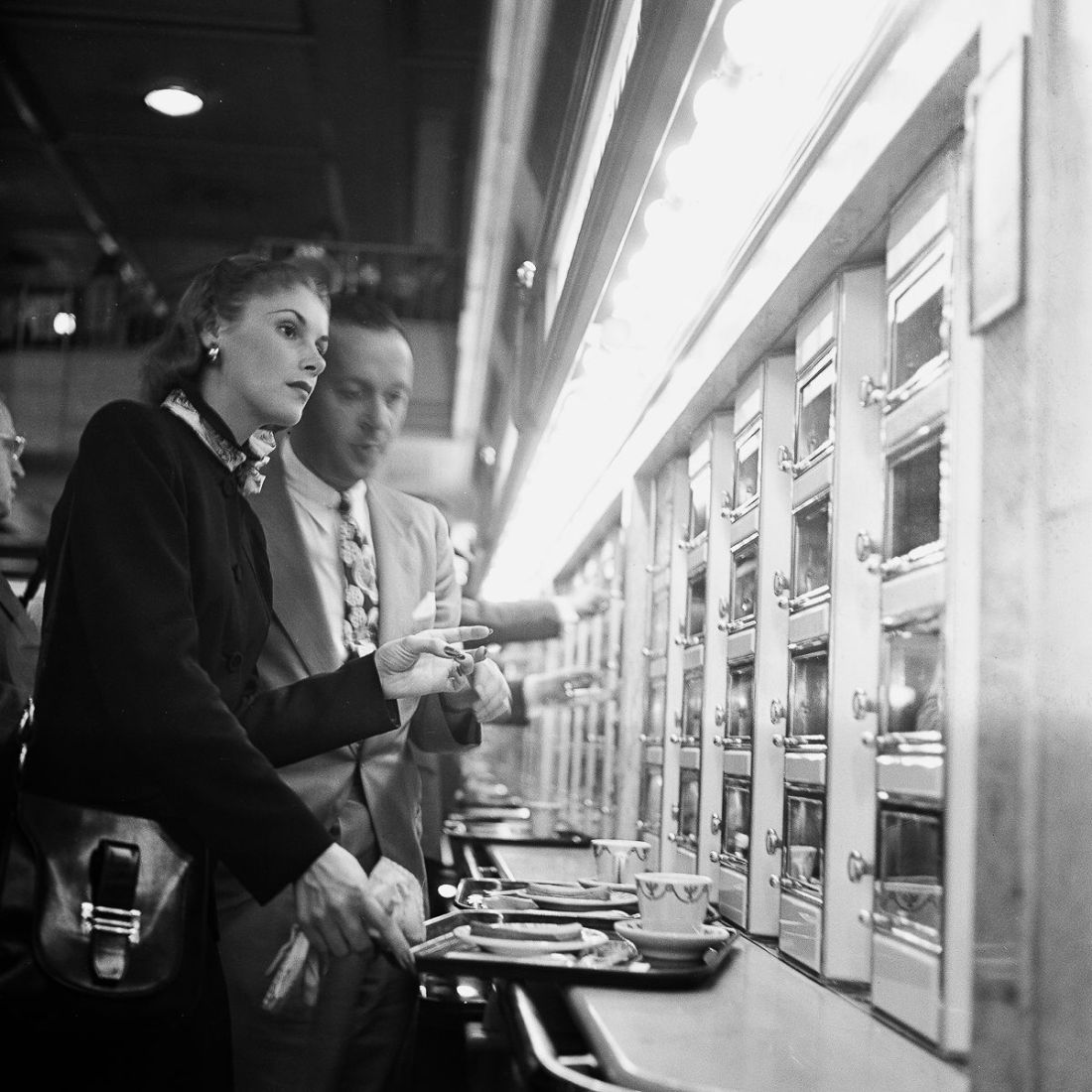
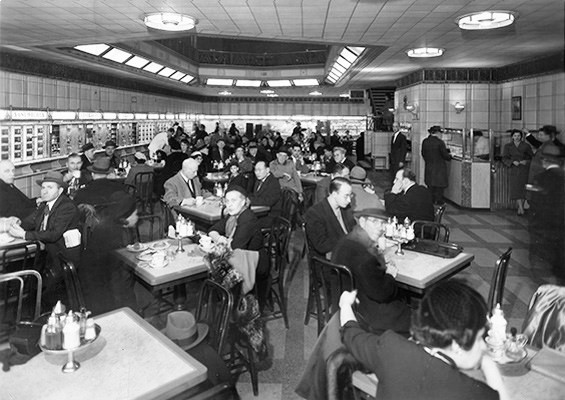
And while I personally would’ve come to H&H just for the food, as an admirer of art deco designs, I would’ve definitely returned for the decor! As you can see from the following photos, the H&H decor was so 1930’s art deco New York City!
Horn and Hardart commissioned Nicola D’Ascenza, a well-known artist of the time, to create this imposing stained glass window-topped entrance to their first New York City automat.
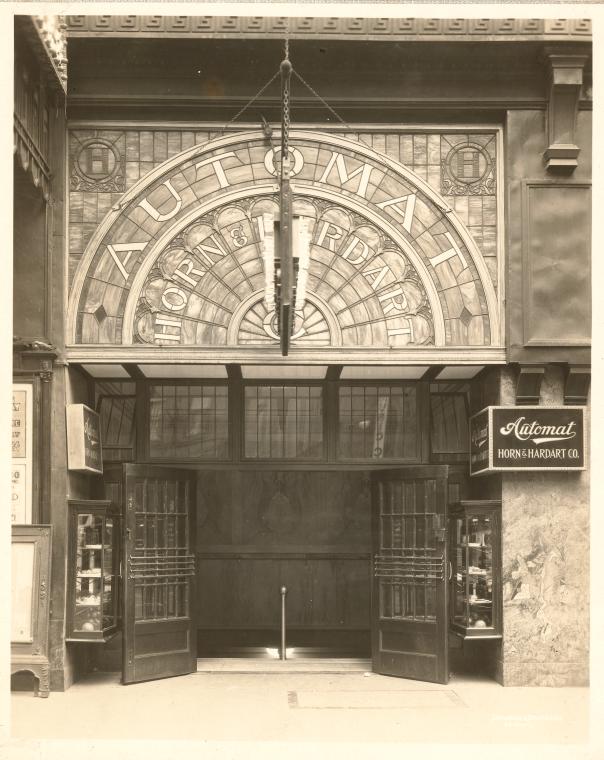
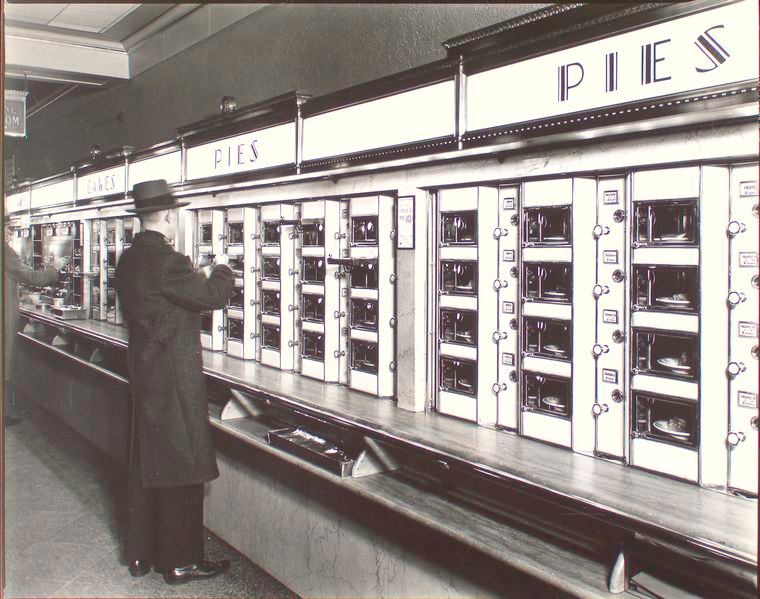
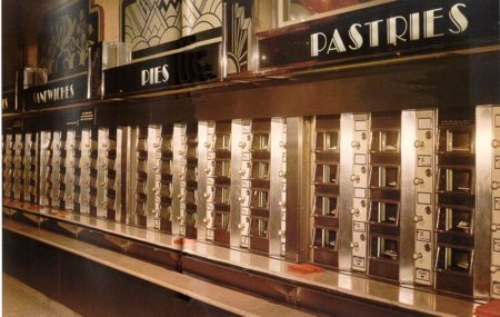
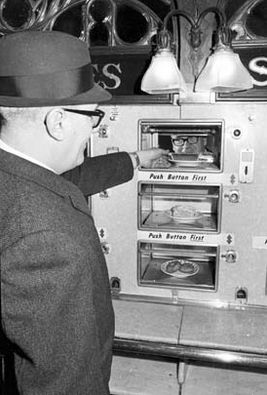
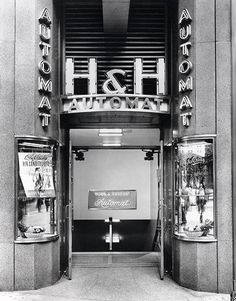
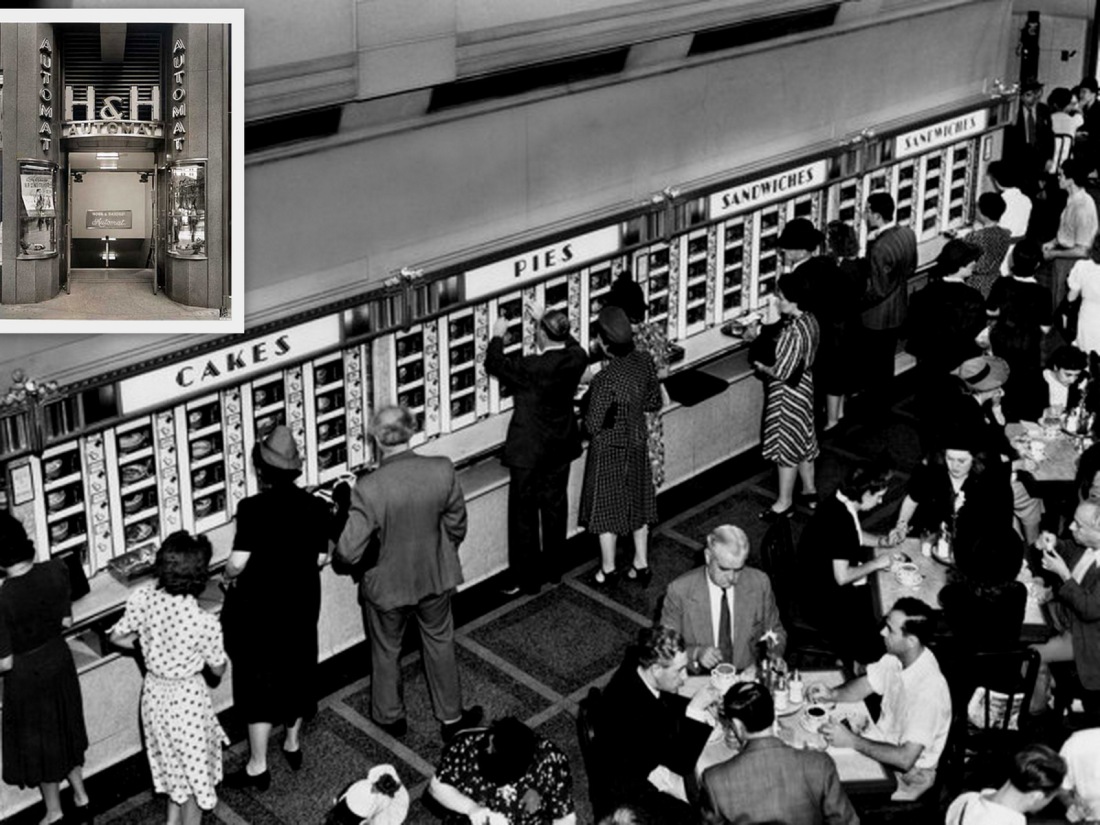
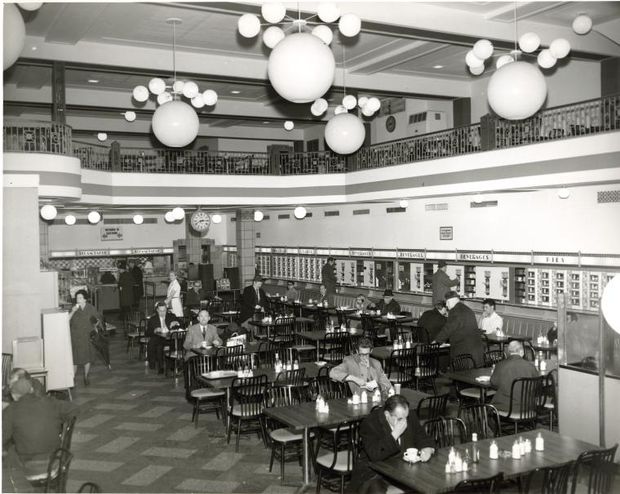
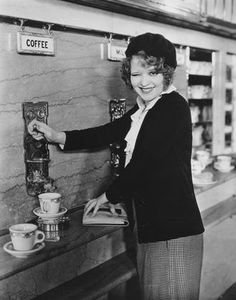
The precise amount of coffee gushed from a chrome coffee machine (the design of which was copied from a Pompeian fountain) at an exactly calibrated temperature.
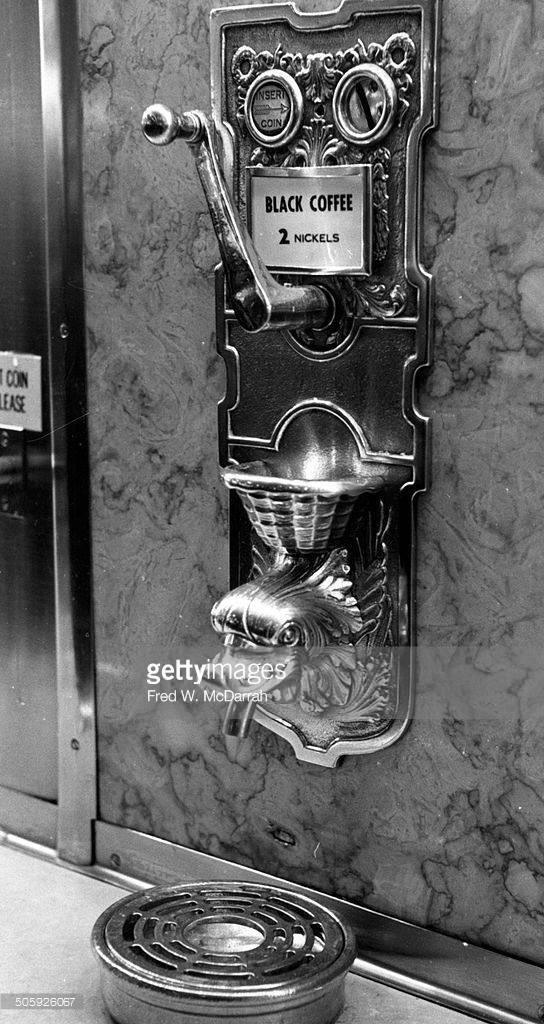
Sadly in the 1970’s, due to America’s changing tastes and lifestyles, the H&H story slowly came to an end. With the advent of such fast food restaurants as McDonald’s and White Castle, consumers no longer appreciated the comfort and gentility of H&H. This was the beginning of the end for H&H and the beginning of the fast food generation.
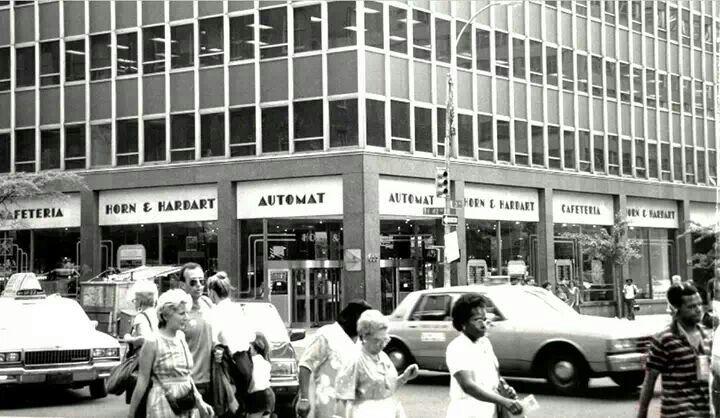
The last remaining Horn and Hardart in NYC (on the corner of 42nd Street and Third Avenue), closed in 1991.
The last H&H (which was located in my neighborhood of 42nd Street and Third Avenue), closed in 1991. And while I personally ate in a H&H only a handful of times, I would gladly go back in time and experience it all over again.
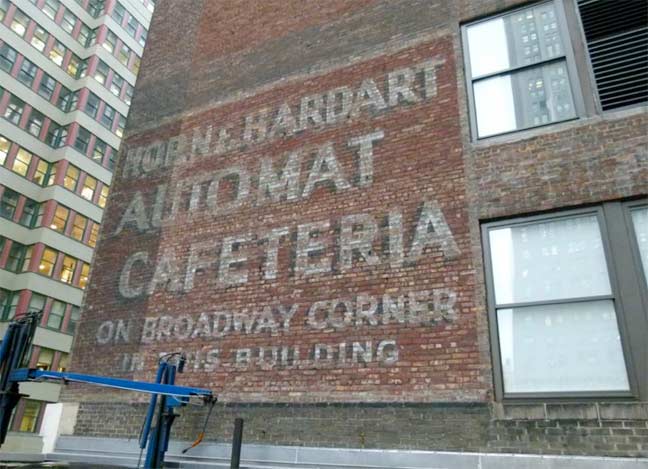
My Dirty Laundry Was Held Hostage by the UN General Assembly
It’s an event that occurs the same time every year in NYC…diplomats from every country and foreign land, descend upon NYC and the United Nations for their annual General Assembly. For many New Yorkers, it’s a non-event. But for those of us who drive or live in the neighborhood of the UN, it’s a logistical nightmare. And sometimes it affects our (MY!) laundry.
Let me explain. I live in a neighborhood called Tudor City which is located on Forty Second Street between First and Second Avenue.
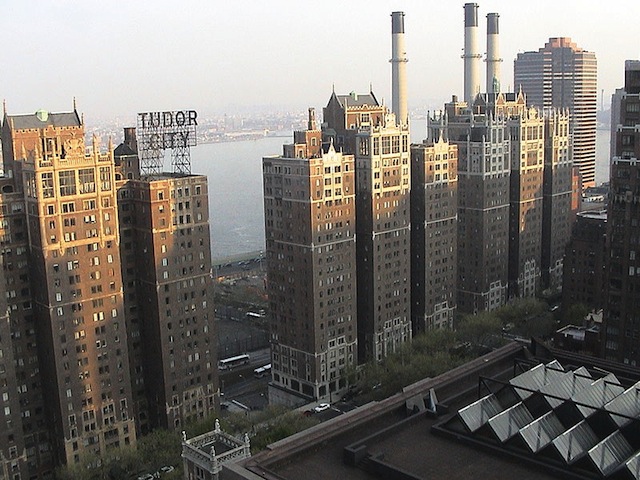
Tudor City
The United Nations is directly across the street located on Forty Second Street and First Avenue. So every year when these wonderful people arrive (along with their entourages that rival the populations of some small countries) , I and my fellow Tudor City-ites are directly impacted.
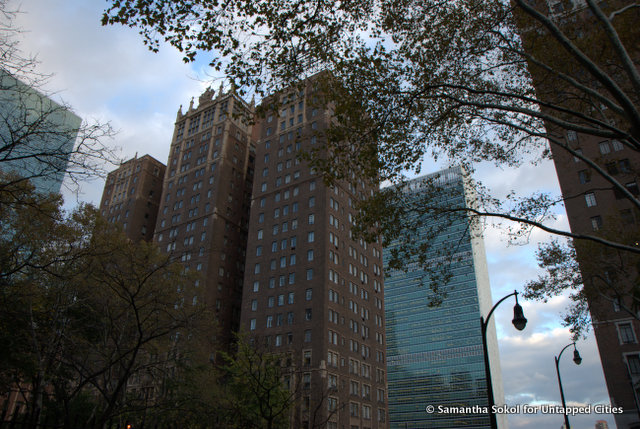
The United Nations is directly across the street from Tudor City
So when I innocently dropped off my dirty laundry at my friendly neighborhood Tudor City dry cleaners, the owner informed me that it may take an extra two (or three!) days for me to receive my clean laundry. The reason?– the overflow of diplomatic traffic will interfere with their pick ups and deliveries.
Imagine my horror at the thought of the cleaning of my dirty jeans being hampered by the arrival of the Prime Minister of Tonga! I had totally forgotten it was THIS time of year AGAIN and the inconveniences it brings!
And it’s not only our laundry that’s held hostage it’s also a change in our whole way of life. Consider…
My Dog Can’t Poo--Thanks to the blocking off of streets in the neighborhood, many of Lulu’s prime pooing spots are all off limits. This leads to a confused Lulu and an extra twenty minute search for her second tier relief station.

What’s a doggie to do when she can’t poo in the spot that she’s always been used to?
You Can’t Walk in a Straight Line–During this week, there’s no straight walking going from A to B. it’s more like going from to A to C then back to B. Imagine Dear Reader, walking down the street, wanting to simply cross the street RIGHT IN FRONT OF YOU but being stopped in your tracks by a police officer saying you have to cross over to the other side of the street, walk down the block and THEN cross over to the street you wanted to be on in the FIRST PLACE!
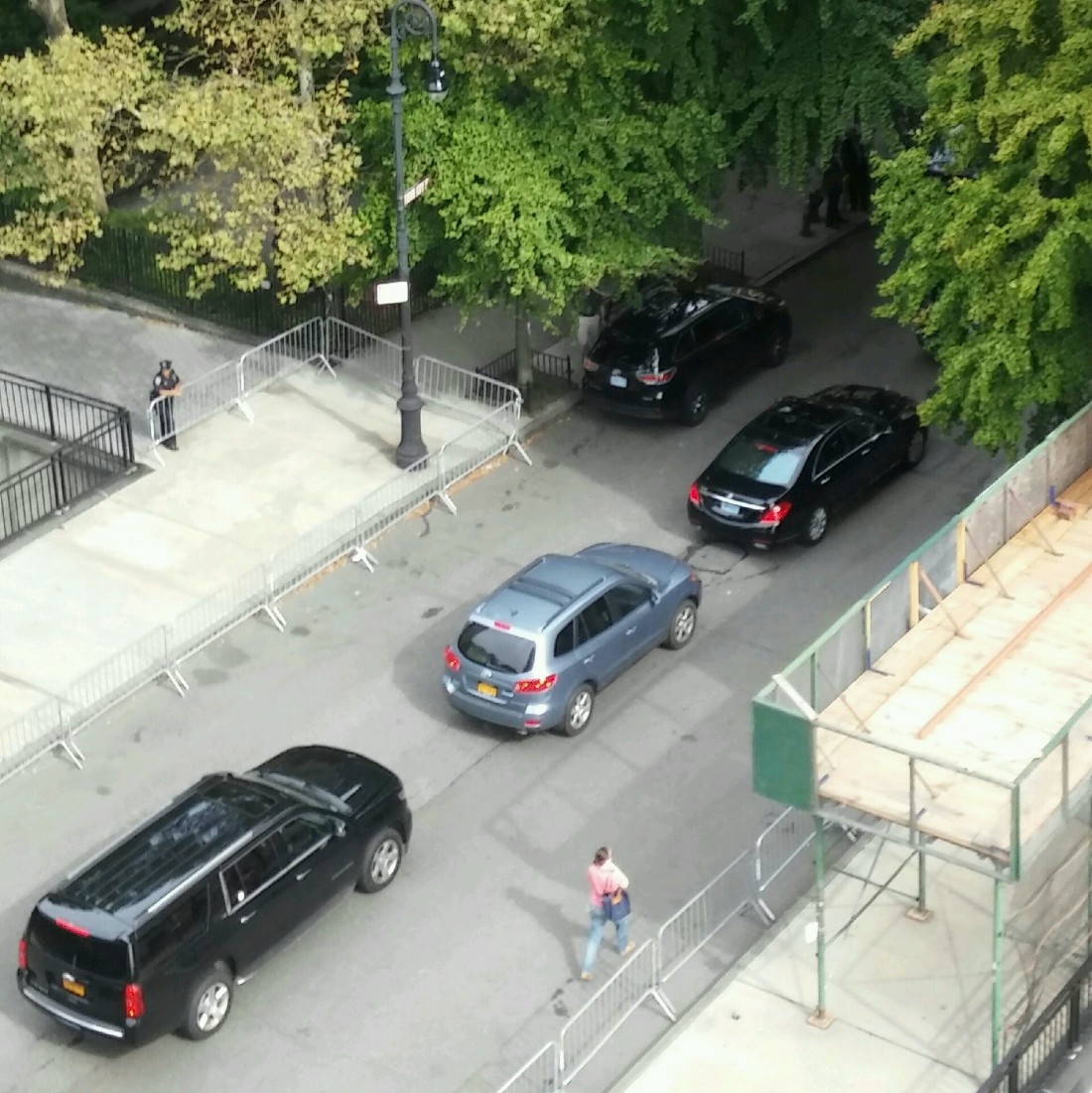
I sure feel safe knowing that lamppost is cordoned off! (view from my window in Tudor City)
You Have to Wait to be Told When to Walk–Imagine you’re running late for work, you’re one block away from Grand Central to catch your train and then from out of nowhere a police officer appears and stops you in your tracks because Vasile Andonoski of Macedonia and his forty eight cars full of his assorted entourage must roll by first. It’s enough to drive a normal person insane!
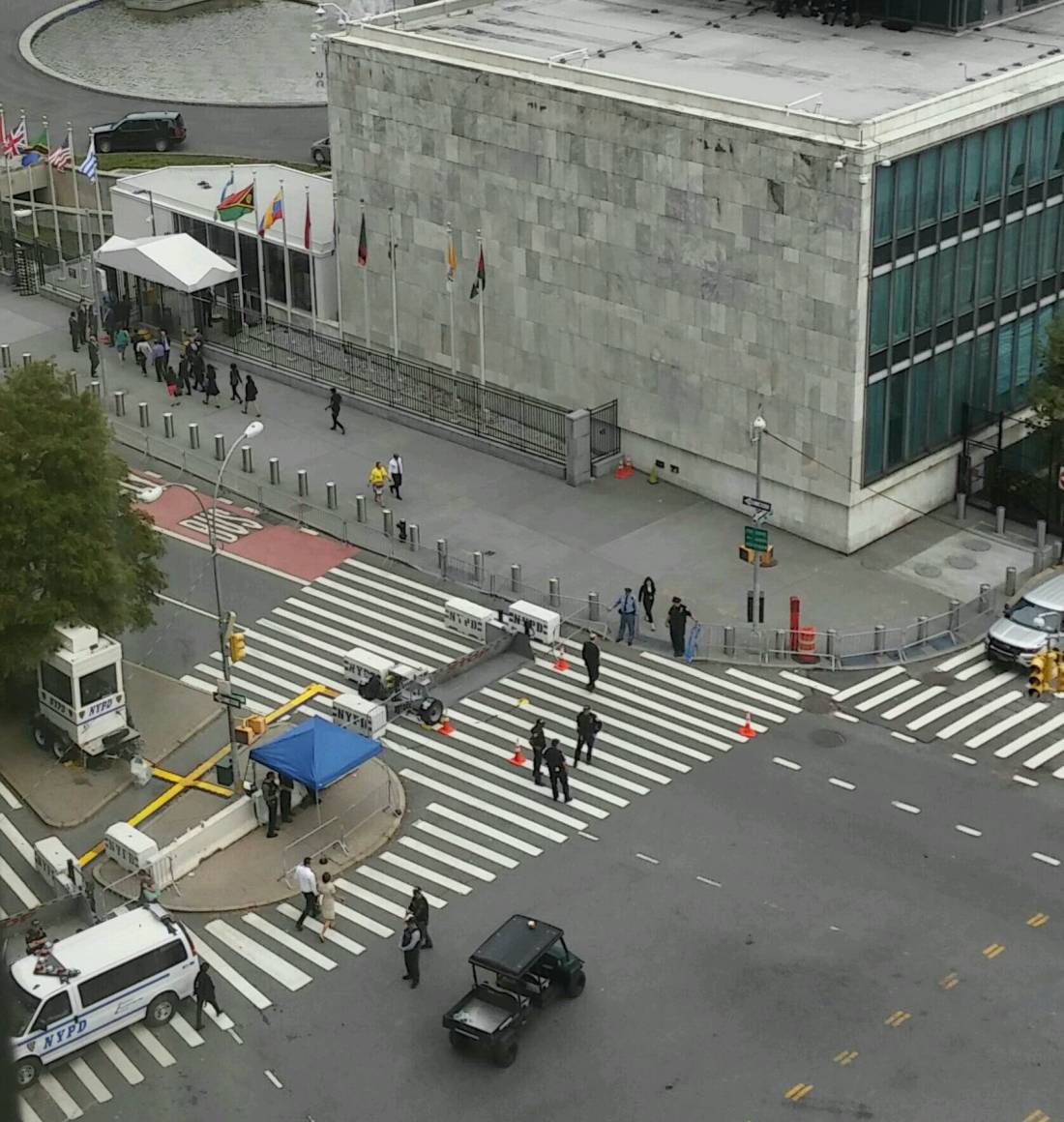
The maze of blockades protecting our foreign visitors. (view from my window in Tudor City)
Traffic is at a Total Standstill— My preferred mode of transportation is the bus (unless I’m in a rush in which case I take the subway). I particularly like taking the bus home because I like the calming effect it has on me. During this week from Hell however, I feel anything but calm thanks to the onslaught of extra traffic and street closures which invariably causes my bus to move at an increasingly snail’s pace.
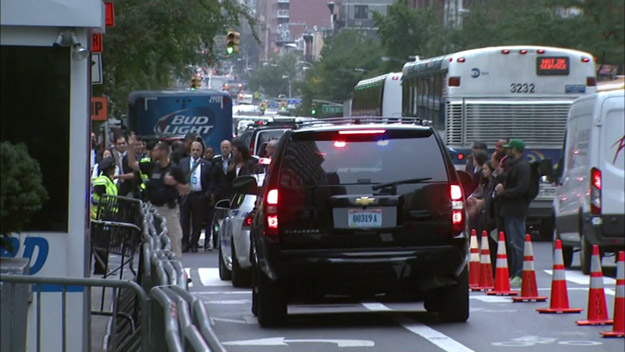
Ain’t nobody goin’ nowhere this week!
And while I may not be in a rush to get home, I would like to arrive home sometime within the parameters of the same day. So usually this means that I must either get off the bus and walk or take the subway. My previous sense of calmness has now left the building.
Now of course, these are actually minor (and I admit rather silly) inconveniences. And while these diplomats do bring a ton of money to NYC during their stay, there is evidence however, that there are some diplomats who actually create debt for the city.
According to a study conducted by The City of New York, diplomats owe NYC $16,024,266 in unpaid tickets.
One of the biggest offenders is North Korea. Yes Rocket Man owes New York City more than $156,000 from 1,300 unpaid parking tickets dating back to the 1990’s.

Another reason to hate Rocket Man…he doesn’t pay his country’s parking tickets!!
As I mentioned earlier, while many of the visiting dignitaries are quite good at spreading their wealth around, there are some however, that are actually quite cheap when it comes to their dining out expenses. According to a waiter at Cipriani, “diplomatic meals are tax-free, and sometimes heavily discounted. They don’t have to pay tax and then my manager makes me give them a big discount. Then there’s hardly anything left for me and they never tip anyway.”
But these infractions are minor however, compared to the diplomat that ALMOST got away with murder!
Back in 1997, Gueorgui Makharadze, a diplomat from the former Soviet Republic of Georgia stationed in Washington, DC was drunk behind the wheel when he slammed into a parked car which flew through the air, landed on another car and killed Joviane Waltrick, the sixteen year old passenger sitting inside. Makharadze was driving at the speed of 80 miles an hour.

Gueorgui Makharadze
Prosecutors were successful in waiving his immunity and getting him charged with involuntary manslaughter. He was handed a seven to twenty one year sentence BUT only served three years of that sentence. The reason?–diplomatic bargaining between the US and Georgia. As Mark S. Zaid, the attorney representing Joviane’s mother said, “these are decisions between countries, not individuals.”
But now back to me and my dirty laundry…if there’s any UN diplomats out there that happens upon a wayward Tudor City laundry truck, please include him in your entourage and let him drop off my clothes at my building. I (and my fellow co-workers) will be most appreciative!
So what about you Dear Reader…have you been affected by this week’s UN madness and how do you deal with it?
How Wonder Woman Beats NYC Traffic

We’ve all been there–riding on the bus on our daily commute, everything’s going smoothly until…the dreaded traffic jam. Every morning I ride the M57 bus which takes me from Fifty Seventh and First Avenue to Fifty Seventh and Tenth. Most mornings, things keep moving, but every so often, thanks to the myriad of unneeded apartment buildings under construction along the route, traffic comes to a complete standstill. Today was just such a morning.
Under circumstances like this, you really have only two choices–succumb to the sleepiness that is slowly overtaking you thanks to the slow motion rocking of the bus OR take a deep breath, suck it up and walk the rest of the three (three LONG CROSSTOWN) blocks to my destination. I choose the latter.
As I put my trusty backpack in place, I creep slowly up the avenue, trying to lose the sleepiness that’s still coursing through my veins. Eventually however, I get a second wind and as I slowly begin to pick up speed, I imagine myself that package of superhuman agility, brains and brawn…I am Wonder Woman!
With that image in mind, I’m able to quickly avoid the hot dog vendor cart coming right at me as I quickly veer left!
Now heading up Eighth Avenue, my striding in full gear, I almost nick the tourist right in front of me clear off her feet! (How dare she stand on the street, anyway!)
As I catch my image in the passing shop windows, I admire how my hair blows gloriously in the wind, my legs lean and muscular as I quickly maneuver left then right through the oncoming NYC crowds. As I quickly glance again, I swear I catch the glint of my Bracelets of Submission as they glisten in a passing store window!

The Bracelets of Submission
Looking up, I now notice that the bus that I was stuck on earlier is slowly catching up to me. As I quickly pick up my pace, I swear I feel like my Skechers Go Walk Sneakers (hey, I said I was quick, I never said I was stylish!), are actually running on air…like the superhero, superwoman I AM!! And of course, with my superhuman flight speed I have beaten the bus at its own game!

My Skechers Go Walk Sneakers (don’t be hatin’!)
With my Lasso of Truth firmly in place, I now lock eyes with the taxi driver who’s determined to run me over as I try to cross the street/finish line to Tenth Avenue. “You will not defeat me!”, I whisper as I look him fiercely in the eye (take THAT Tyra Banks!). As I step confidently off the sidewalk, I give one final glowering stare to the driver and glide swiftly across the street!
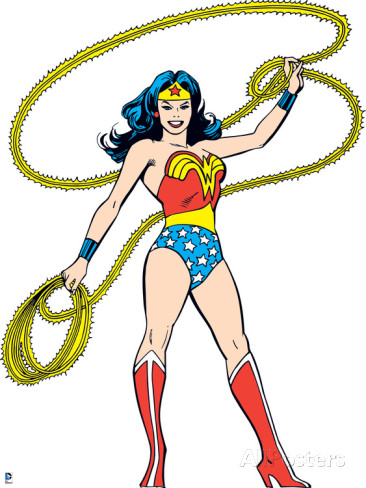
The Lasso of Truth
As I arrive triumphantly at my destination, I celebrate the female warrior that I am! I am strong, I am invincible, I am WOMAN! (thank you Helen Reddy!). As I start to notice the strange stares and scowls from my fellow co-workers however, I am slowly turning mortal again and the Wonder Woman image is beginning to wear off. Suddenly, I’m just me again and then as I head to the ladies room dripping in sweat, it hits me…
I could never be Wonder Woman. Wonder Woman always looked fabulous. Wonder Woman didn’t perspire. Wonder Woman didn’t have sweat stains. Wonder Woman always had great hair. And as I look in the mirror, my hair a frizzy mess and my waterproof mascara failing the sweating test, I’m no longer a super hero. I’m just me. The Wonder Woman costume has sadly come off.
After I comb my hair and reapply my makeup however, I take a deep breath and my confidence is slowly restored. And as I’m about to leave the ladies room, I take one last look in the mirror and I swear I catch a faint glimmer of my golden lasso. I then smile broadly and think, “well, tomorrow IS another day in the Big, Bad Apple”.




